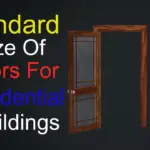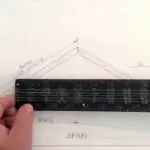Partition walls are an easy way to give your office or home the extra privacy it needs. The right partition wall can even make your space feel more open and airy. Partition walls can serve both functional and decorative purposes. So there’s no reason to settle for boring dividers in your office or living rooms. You can buy partitions that are as unique as you are!
Below, we’ll discuss 8 different types of partition walls, including there applications and where they work best.
Types of Partition Walls
Clad Wood:
Clad wood is essentially a hollow-core door wrapped in wooden planks. It is typically plywood and is lined with thin sheets of decorative wood, sometimes even inlaid with metal. The beauty and versatility of clad walls has made them very popular for modern architecture. But they’re not always right for every space. Clad walls are often painted on both sides. But if you’re hoping to keep a room bright, it can limit light transmission.
Engineered Wood:
Engineered wood is popular for its versatility. These wall panels come in a variety of styles, including picture frame, stave, shadow box, and grooved-board. They’re easy to cut down to size and are widely available. If you have engineered wood paneling at home or office, there’s a good chance you can find it online. You can easily achieve a good texture wall.
Hidden Wood:
When you’re looking for a partition wall that can double as an accent piece, consider hidden wood. Panels made with real wood are not only beautiful, but they provide a unique look that will separate your room from other rooms in your home. Hidden walls allow you to be creative in terms of storage solutions. These walls often hide additional storage units (or drawers) behind them which can help free up space in other areas of your home.
Also Read: Retaining Wall Types
Brick:
Brick is a very popular material for partition walls. It has a nice look, is durable, and provides privacy. Brick partition walls are great for creating unique interior spaces or dividing up open-space rooms.
Thin Stone:
Thin stone, also called lightweight stone, is a popular choice for partition walls in both commercial and residential construction. It is typically installed on floors and walls in interior applications, but it can also be used as exterior siding. Thin stone usually comes in 2-by-2-inch or 2-by-4-inch panels that are easy to cut with a handsaw or utility knife.
Also Read: Types of Walls in Construction Buildings
Plasterboard:
Plasterboard walls are often used in combination with wooden frames for flats, offices, hotels, restaurants and hospitals. It is composed of a sheet material made out of gypsum plaster that has been paper-pasted. While it is widely available in most hardware stores and DIY shops, you may not be able to get your hands on all kinds. For example, thicker plasterboard sheets will require professional installation due to their weight while thinner ones can be installed by most DIY enthusiasts if they have sufficient knowledge about partitions.
Glass Partitions:
These are essentially walls made out of glass panes. They’re great for creating an office environment that feels more collaborative—they also allow employees to have some privacy, which is especially important if you have client meetings going on in your office all day long. Depending on your budget, you can add frosting or a border around each pane. You might also consider using mirrors instead of glass, since they offer much more privacy than regular windows do.
Also Read: Shear Wall, Types, Uses, Advantages Disadvantages
Acoustic Panels:
Acoustic panels are great for reducing reverberation in spaces with a lot of exposed concrete or brick. They’re typically made from wood or gypsum board, but they can be built into walls or suspended from ceilings. When you combine acoustic panels with sound absorbing insulation, you have a one-two punch for taming noise in a small space.
Which material is best used for partition wall?
When building, renovating or remodeling your home, you’ll have to make many important decisions that will affect the way your house looks and functions. One of the choices you’ll have to make involves partition walls. These walls divide one space from another and come in many different forms. These wall are commonly made from different materials such as wood, concrete or steel and they can be built in any height depending on your needs.
Partition Walls – Pros and Cons:
Partitions are great for keeping a room divided, but as with everything in life, there are pros and cons to every material. For example, drywall is cheap and easy to install; however, it’s bulky and hard to remove. Meanwhile sheetrock is expensive and time-consuming to install; however, it can be easily removed if need be. Understanding these differences can help you pick out your ideal option!
Also Read: Parapet Wall
Exterior Partition Walls – Pros and Cons:
Like any other product on your property, your home’s exterior walls should not be dismissed lightly. Many of us never give them a second thought, and we often pass over them with little more than a glance. But they play an important role in our lives, and they can certainly impact both how safe and secure we feel when inside our homes as well as how good we look to those who visit us at home.
Interior Partition Walls – Pros and Cons:
Interior partition walls are often made from plywood, with an attractive laminating veneer to make them look more attractive. The inside of a standard interior wall can be sheathed in drywall or plasterboard. In addition to being fire-resistant, interior walls are easy to modify because they provide access to plumbing and electrical utilities that aren’t accessible in exterior walls.
Airtightness, Acoustic Comfort, and Thermal Insulation:
While each type of partition wall has its own advantages and disadvantages, airtightness and acoustic comfort are two major factors to consider when choosing a partition wall. All other factors being equal, airtightness is better than lower levels of airtightness because it decreases your heating and cooling costs. But if a non-airtight partition offers other desirable features, such as sound insulation or ease of installation, then that may make it preferable to an airtight option.
Price – Cheapest Material
While renting drywall, gypsum board and insulation will set you back $30-100+ per sheet, plasterboard won’t cost much more than a drywall rental. You can expect to pay around $40-80+ per sheet. If durability is an important factor in your decision-making process, consider that plasterboard lasts longer than both of these options—and that it’s not susceptible to mold or moisture damage like its counterparts.
























